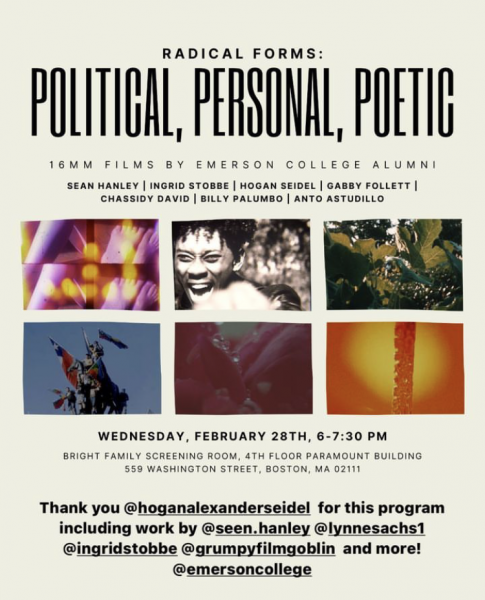
Wednesday, February 28th 2024, 6-7:30pm
Bright Family Screening Room 4th Floor Paramount Building
559 Washington Street, Boston, MA 02111
STARFISH AORTA COLOSSUS made with Sean Hanley
16mm Films by Emerson College Alumni
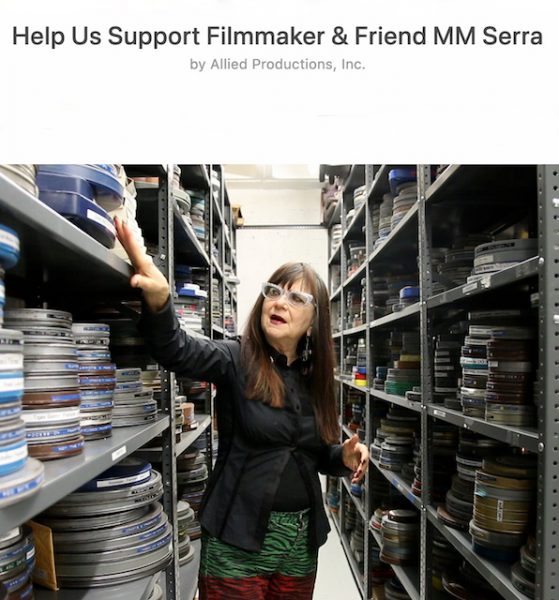
We need your help and support to raise money for our dear friend and beloved community member, MM Serra. We’re asking you to contribute to a fund that will pay her apartment rent for the next two years. This will guarantee MM’s security and well-being through December 2025.
MM Serra is a filmmaker, curator, and adjunct professor at The New School. Until recently, she was Executive Director of the Film-Makers’ Cooperative, the world’s oldest and largest distributor of independent film, where she served on staff for 32 years. She has taught courses on cinema at The New School since 1998 and has made over 34 films, which have screened at venues like MoMA, Sundance, and the Tribeca Film Festival. In March, the Society for Cinema & Media Studies’s annual conference in Boston will feature the roundtable discussion, “A Celebration & Reflection on Filmmaker, Curator MM Serra’s 30+ Years as Executive Director of Film-makers’ Cooperative.”
In the last year, Serra has experienced significant life changes, which have left her in a precarious financial position. Since transitioning off of the Coop’s staff, Serra has been living in New York City without a substantial source of income and has been subsisting on social security, a meager adjunct salary, and modest savings. In addition, Serra had a serious health scare last summer. She underwent emergency surgery in July and was hospitalized for several days afterward. This left her with thousands of dollars in medical bills, as well as an increased need for long-term medical care and home care.
Despite these issues, Serra has continued production on several new films. She has also maintained an active teaching schedule at The New School, and has worked to develop new programming projects to support artists in her community. Her philosophy of making art no matter what life throws at her has inspired us all. As her friends, we believe that giving her this rent stability will allow her to direct her income toward other material needs, while also enabling her to continue her active and necessary artistic practice.
The major reason we are working to raise money for Serra is because she has dedicated so much time and labor to supporting the independent film community in New York. As the Executive Director of the Film-Makers’ Cooperative, for instance, Serra guided the organization through two major relocations, supported the distribution of films in the collection, secured grants and other forms of financial assistance for the organization, curated innumerable screenings of artists’ work, and oversaw numerous restorations of independent media. Serra’s work for the Coop involved long hours and little pay, but she did it with love and joy, giving her whole self to our community.
We are seeking to raise $27,000, as this would cover two years of rent for Serra’s apartment in the Lower East Side, where she is an active and celebrated presence in the neighborhood. The monthly rent will be paid from the fund directly to Serra’s landlord. Contributions made to Allied Productions, Inc., a 501(c)(3) non-profit arts service organization, are tax deductible to the full extent allowed by law. If you prefer to write a check directly, please make payable to Allied Productions,Inc. earmarked for MM Serra Fund and mail to PO Box 20260 New York, NY 10009. Donors will receive a letter from Allied Productions, Inc. with information confirming the tax deduction. An administrative fee of 9% has been calculated into the campaign’s target goal delegated for the administration of the funds of MM’s rent each month.
MM Serra has meant many things to each of us. Over the next few weeks, we, along with a few invited guests, will be sharing a range of narratives testifying to Serra’s remarkable contributions to our community. Stay in touch for some great slices of underground experimental film history!
In health, solidarity and enthusiasm,
Friends of MM Serra, Members of the Film-makers Cooperative(FMC), **FMC’s Advisory Board:
Peggy Ahwesh, Josh Guilford, Devon Narine-Singh, Lynne Sachs, Peter Cramer, Jack Waters
* Allied Productions,Inc (for identification purposes only)
I first met Serra when she arrived from Los Angeles, wearing high heels, fabulously sexy black bangs (much like Pabst’s Lulu), and designer coats. I warned her about those heels, saying “you have to be able to run in NYC.” She was a fashionista then and still is. Together, along with Robert Hilferty (brilliant ex-student of mine from NYU and a filmmaker in his own right), we
co-curated Conspiracies over a weekend in May 1988 at Rapp Arts Center, a Catholic church and nun’s residency hall in the East Village (not incidently, where I had edited Mayhem (1987) in a 8’ by 15’ nun’s bedroom, with hardly space for the Steenbeck plus an editing chair.) MM being Catholic, particularly enjoyed screening our outrageous experimental films there. They had a remarkable theater with tragedy-comedy plaster masks centered above the proscenium arch. The line-up of filmmakers on those programs included Todd Haynes, Lewis Klahr, Mary Filippo, Joe Gibbons, Erika Beckmann and other key members of the downtown NYC avantgarde. The poster included Weegee’s famous photograph of a mobbed Coney Island, and our several shows, too, were mobbed and exhilarating. I should add our projectionist was Alex, then, the mixer at Duart Labs, who magnanimously volunteered to work the event. There we were, up in the booth, where things went a bit crazy, as they easily could do screening a long list of short experimental films!
It was successful and fun enough, so that in May 1990, we did another Weekend and then in 1991, Serra and I curated a Valentine’s Day Film Night at WEBO Gallery downtown. Later, Serra single-handedly curated another show, again at Rapp. The most memorable for me from that program was Nick Zedd’s War Is Menstrual Envy, which had Annie Sprinkle cuddling a burn victim. Disturbing and unforgettable. Just what MM loved: sex and shock.
We became fast friends. A bit later, MM was showing her films in S and M dungeons downtown. She had shared her sexual history with me, which involved abuse as a child, abuse that her mother denied. Around then, she showed me her film of her mother, Reel to Real Momma (1982), and the image of her mother staring out at the audience, so harsh, so cold—I felt for her. The person in her family whom she loved the most was her Dad, whom I was privileged to meet. He worked as a coal miner; small and round, he was the opposite of the mom. And he loved gardens. At that point I was a member of a community garden in the East Village, and he would come by and visit, talking about plants and gardening. He was happiest there. Serra has a plot now in the community garden at 6th Street and Ave. B. Digging in the garden is always a pleasure, grounding, quite literally.
There was a time when we tried to do a film together on bisexuality. It didn’t quite work out. But there she was, clicking in her heels across the wood floor at Westbeth where we were shooting. Either later or just before, Peggy Ahwesh and I shot for her film, Soi Meme, on female ejaculation. Quite fun, even if I remained skeptical about what we were seeing.
Serra took on the job at the film coop not long after. She remained always supportive, and always active. In many ways, she brought the Film Coop into the 21st century, getting the films out to an international audience, travelling with them and curating shows, often of women or lesser known and/or forgotten filmmakers. While working, she studied and graduated with an advanced degree from New York University, remaining dedicated, determined, and loving cinema. She moved ahead no matter the problems, curating shows abroad and establishing an ongoing tradition of exhibition at the Coop itself, continuing to make her own films. She was living on very constrained finances, yet still a fashionista, showing up in wonderful idiosyncratic style, discovering and befriending downtown designers, heralding them just as she did the Coop’s filmmakers. She remained an eccentric beauty, even as she switched from high-heels to baseball shoes. During this time, she was also teaching at the New School, enabling her to influence and bring to experimental cinema a new crop of devotees. She influenced so many people, building community. She worked with Michelle Handleman, Peggy Ahwesh, Jennifer Reeves, Tom Chomont and myself, among others.
Most particularly, I will never forget those incredible Rapp shows and the group of people we brought together in New York: this moment of unity, a fantastic cross-section of filmmakers just as New York was coming out of the 1980s, funky with drugs and a reputation for danger popularized by the film “Escape from New York”. We never ‘escaped’ but stayed, to continue our love affair with the city and cinema, sustaining experimentation, friendship and community.
Abigail Child
Bogliasco, Italy
Feb 14th, 2024
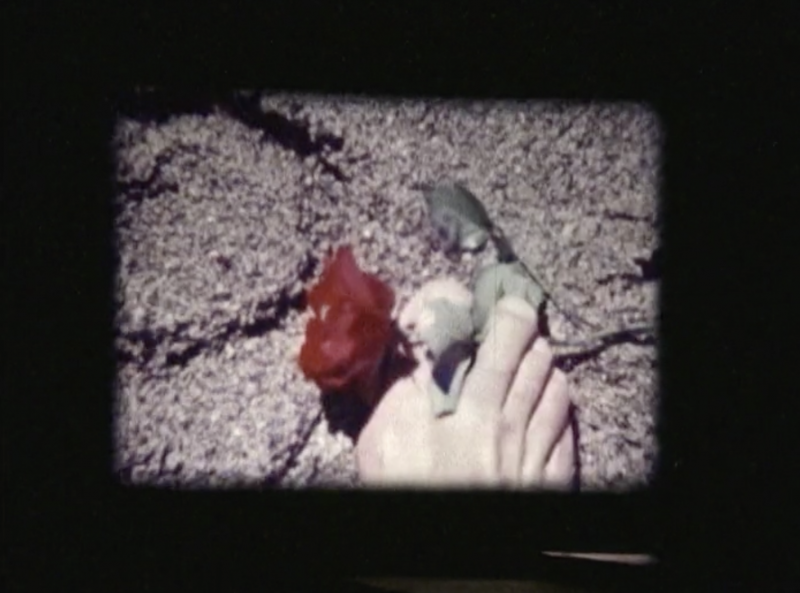
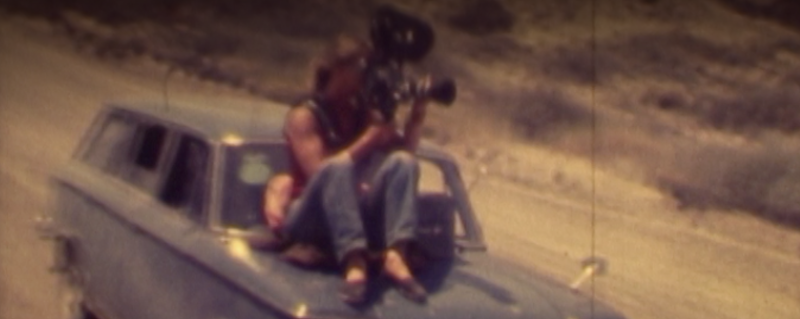
In August of 2008, I was living in Buenos Aires with my family. I was able to meet and spend quite a bit of time with artist filmmaker Narcisa Hirsch.
In this conversation, we talk about so many things including: her belief that painting on an easel had died, “Happenings”, her collaborative Marabunta (1967) feminist performance, her discovery of 16mm, watching Michael Snow’s “Wavelength”, creating “Taller” a response to Snow’s ideas, a 16mm visualization of Steve Reich’s “Come Out”, her friend and collaborator Marie Louise Alleman, “Fuses” by Carolee Schneemann which was her first film purchase, making films in the troubled 1970s in Argentina, owning films by Su Friedrich and Stan Brakhage, rejecting making feature films with a script, filming daily life, her being world famous for 50 people, remembering Laura and Albert Honig (Argentine experimental filmmakers), support from the Goethe Institute, making “radical” work that did not threaten the government, “I didn’t go to jail because they didn’t want me,” giving away 500 little dolls on the street and saying “you have a baby” in NYC, London and Buenos Aires. All of these Happenings were filmed and each was very different, she was doing this during the same time that Cesar Chavez was encouraging people to boycott lettuce. She defines what a “happening” is including public participation and very much not a conventional gallery show, art was no longer “re-presentation” but now is a situation, not isolated from the public but including the public. They talk about Ramundo Glazer who was one of the Argentine disappeared.
Then we watch her film response to Steve Reich’s “Come Out”, film diary footage from summer 1973, close ups of leaves and water, her feet, a fly, her shadow in the sand as she carries her film camera, cherries on skin, a fly, a mouth luxuriating at the taste of fruit, a baby on the grass., a breast and a belly in the sunlight, a fly.
with Paula Felix Didier, Ruben Guzman, and Maya and Noa Street-Sachs

Festival address: 718 5th Ave. Park Slope, Brooklyn
3:20 p.m. Mark Street (essayist)
3:55 p.m. Lynne Sachs (essayist)
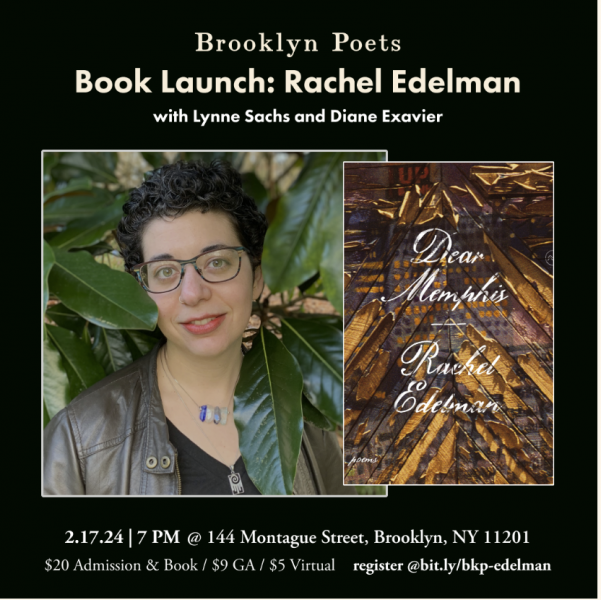
https://brooklynpoets.org/events/all/brooklyn-poets-book-launch-edelman
Saturday, February 17, 2024
7:00 PM 9:00 PM
Brooklyn Poets, 144 Montague StreetBrooklyn, NY, 11201
Join us for the launch of poet Rachel Edelman’s new collection of poems, Dear Memphis, on Saturday, February 17, at 144 Montague St and via Zoom! Doors will open for a wine reception for in-person guests at 6 PM and readings will begin at 7 PM. Lynne Sachs and Diane Exavier will open for Edelman. Book signing to follow.
Note that by attending this event, you agree to abide by our code of conduct and COVID-19 policy below. Effective January 8, 2024, all event attendees except readers at a safe distance on stage are required to wear masks due to the current rise in cases in NYC. Our full policy can be found at the end of the event description. Brooklyn Poets reserves the right to dismiss from our programs any participant found to be in violation of these policies. Thank you for respecting our community.
“What do I know of exile?” asks the speaker in Dear Memphis, standing inside the colliding geographies and intimate economies of the American South. Offering a direct address to the city where the poet grew up, this collection explores the displacement and belonging of a Jewish family in Memphis, Tennessee, alongside their histories of community and environment. The simultaneous richness and spareness of Edelman’s poems sing with their attention to the particular body and what it cannot carry, what it cannot put down. Through letters, visual art, city documents, and dialogue, Dear Memphis excavates ancestry, inheritance and the ecological possibility of imagining a future.
Rachel Edelman is a Jewish poet raised in Memphis, Tennessee, who writes into diasporic living. Dear Memphis, published by River River Books, is their debut collection of poems. Her poems have appeared in Narrative, the Seventh Wave, the Threepenny Review, West Branch and many other journals. They have received material support from City of Seattle Office of Arts & Culture, the Academy of American Poets, Mineral School, Crosstown Arts, and Tin House, and finalist commendations from the Adrienne Rich Award, the Pink Poetry Prize, and the National Poetry Series. Edelman earned a BA in English and geology from Amherst College and an MFA in poetry from the University of Washington. She teaches language arts in the Seattle Public Schools, where embodiment and care root her personal, poetic and pedagogical practice.
Lynne Sachs is a filmmaker and poet who grew up in Memphis and lives in Brooklyn, New York. Over the last four decades, she has created cinematic works that defy genre through the use of hybrid forms and cross-disciplinary collaboration, incorporating elements of documentary, performance, and collage. Her films and poems explore the intricate relationship between personal observations and broader historical experiences, often from a personal, self-reflexive point of view. With each film, Sachs investigates the implicit connection between the body, the camera and the materiality of film itself. Her early works on celluloid offer a feminist approach to the creation of images and writing— a commitment which has grounded her vision ever since. Early in her career, Lynne returned to her hometown to make Sermons and Sacred Pictures (1989), a documentary on the life and work of Reverend L.O. Taylor, an African American minister and filmmaker from Memphis. Lynne’s films have screened at the Museum of Modern Art, the New York Film Festival, and Sundance. Retrospectives of her work have been presented at the Museum of the Moving Image, Sheffield Doc/Fest, Buenos Aires International Festival, Festival International de Havana, and China Women’s Film Festival.
Diane Exavier is a writer, theatermaker and educator working at the intersection of performance and poetry. She is author of the poetry collection The Math of Saint Felix and the chapbook Teaches of Peaches. Diane concerns herself with what she recognizes as the 4 L’s: love, loss, legacy and land. Her work has been presented with the New Group, BRIC Arts, Bowery Poetry Club, Dixon Place and more. She has been commissioned for new play development by the Sloan Foundation, the New Group, and Lucille Lortel Theatre. Most recently, Diane coedited the 2023 new critical edition of Jean Toomer’s Cane. A 2021 Jerome Foundation finalist, Diane lives and works in Brooklyn.
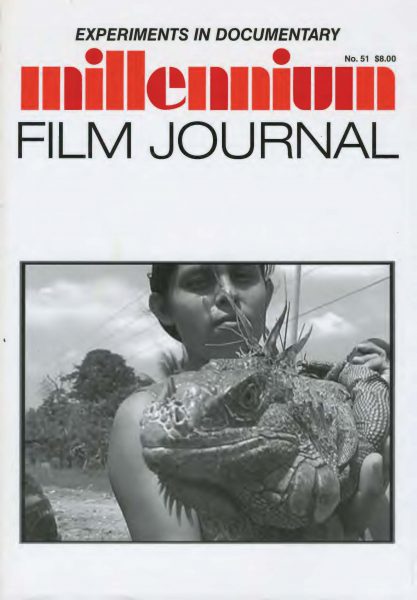
Note: Download the full PDF at bottom of page.
To purchase a paper copy:
https://millenniumfilmjournal.com/product/mfj-51-experiments-in-documentary/
Director of the Millennium:
Howard Guttenplan
Senior Editor:
Grahame Weinbren
Guest Editors:
Lucas Hilderbrand and Lynne Sachs
This special issue has been funded in part with a grant from the Humanities Center at the University of California, Irvine. Prior support for this project was provided by the International Film Seminars/ The Flaherty and New York University’s Tisch School of Arts and Center for Media, Culture, and History.
Experiments in Documentary: Contradiction, Uncertainty, Change by Lucas Hilderbrand
Michelle Citron, Donigan Cumming, Jeanne Finley, John Muse and Tommy Becker, Sasha Waters Freyer, Su Friedrich, Richard Fung, Barbara Hammer, Adele Horne, Alexandra Juhasz, Leandro Katz, Ernie Larsen and Sherry Millner, Jesse Lerner, Frédéric Moffet, Lynne Sachs, MM Serra, Deborah Stratman, Mark Street, Tran T. Kim-Trang
Jonathan Kahana & Liza Johnson
Interstates: South of Ten
Tess Takahashi
When We Speak of the Future: An Interview with Julia Meltzer and David Thorne
Greg Youmans
Ghosted Documentary: Chantal Akerman’s Là-Bas
Konrad Steiner
SprocketKitLingoKit
Peggy Ahwesh
the history of dirt
Caroline Koebel
I Want to Have Your Baby
Chie Yamayoshi
Love Stories
Grahame Weinbren
The Cinema of Pessimism
Below is the original questionnaire that we sent to numerous film and video artists whose work crosses between experimental and documentary modes. The questionnaire was sent to a broad swath of media artists, including influential experimental filmmakers and documentarians, single-channel video artists and artists better known for their gallery installations, and various specific folks whose work we admired. As editors, we found it often productive when respondents abandoned the Q&A format altogether and expressed their ideas with their own structures-in the process, making this a dynamic interaction with varied formats. The responses that follow may not directly answer the questions and, in most cases, have been revised from their original versions. – Lucas Hilderbrand and Lynne Sachs
THIS ISSUE OF MILLENNIUM FILM JOURNAL IS ABOUT A BROAD CATEGORY OF WORK THAT WE ARE CALLING “EXPERIMENTAL DOCUMENTARY”: ESSAYISTIC, FORMAL, RESEARCHED, STRUCTURAL, EPISODIC, SELF-REFLEXIVE, IMPRESSIONISTIC, AND/OR PERSONAL FILMS AND VIDEOS THAT EXPLORE SOCIAL ISSUES. AS PART OF THIS ISSUE, WE INVITE YOUR RESPONSES (TO ANY OR ALL) QUESTIONS-AND ENCOURAGE YOU TO REPLY CREATIVELY.
I. DO YOU AGREE THAT “EXPERIMENTAL DOCUMENTARY” IS A VALID CATEGORY? HOW WOULD YOU DESCRIBE IT? WHAT ARE ITS AIMS AND/OR SUBJECTS?
II. HOW DO ARTISTS WHO DO THE WORK OF DOCUMENTARY-AND YET ARE NOT PRIMARILY CONSIDERED DOCUMENTARIANS- CHALLENGE OUR CONCEPTIONS OF NON-FICTION CINEMA? WHAT DO YOU SEE AS YOUR RELATION TO DOCUMENTARY?
Ill. WHERE DOES DOCUMENTARY MEET THE AVANT-GARDE?
IV. WHAT ROLE DOES POLITICAL CRITIQUE OR ACTIVISM PLAY IN YOUR WORK? HOW ARE YOUR POLITICS COMMUNICATED? HOW DO POLITICS AND AESTHETICS INFORM EACH OTHER?
V. WHAT RECENT WORKS OR ARTISTS HAVE INSPIRED NEW WAYS OF SEEING THE WORLD? HAVE INSPIRED NEW WAYS OF THINKING? HAVE INSPIRED CHANGE?
LUCAS HILDERBRAND
At the center of the campus where I now teach is a verdant park with grassy hills, monumental trees, and eclectic fauna. Given its location in an arid part of Southern California, most of these plants are not indigenous and necessitate extensive irrigation. Although the plants are all living, they are not exactly natural, prompting a friend concerned with environmental sustainability to refer to this lush patch of land as “a beautiful lie.” Indeed, it is. And yet, it’s not. This park, from its inception, reveals another controversy. According to local folklore, the park, the logical place on campus for student congregations, was designed in the 1960s to facilitate the quick containment of any uprisings. Today, however, this park is the only area that could be called lovely, and it offers a retreat from the blight of the consistently beige architecture and concrete walks. The park is alive with contradictions.
Inherently, so is documentary. From the start, documentarians have wrestled with a central tension between reality and construction. John Grierson recognized this when he called the emergent mode of documentary the “creative treatment of actuality” in 1929.1 Eight decades later, Jonathan Kahana revisited this assertion, remarking that this phrase “functions as a moment of origin for documentary precisely because it is ambivalent, or simply uncertain, about what the term ‘documentary’ stands for.”2 Typically, the concerns with the contradictions of documentary have spurred debates about truth, ideology, and power-important issues, no doubt, but not exhaustive. The “creative” part of the documentary equation at times gets lost, even though many key works of the documentary canon-and those most often claimed as part of its innovative edge-have not only made claims for truth but have also striven for beauty.
If documentary was first conceived as the “creative treatment of actuality,” influential filmmakers of the American avant-garde, such as Maya Deren and Stan Brakhage, offered creative treatments of experience. These works opened up alternatives to mainstream film that shifted focus from the state of the world to states of being. Because so much of this work is formally innovative and the subjective perspectives so interior, at times we forget to ponder how such films speak to the world at large.
At the intersection of documentary and experimental practices, the duality of actuality and creativity energizes artists to make work that is radically beautiful and fantastically true. Authenticity and analogy, indexicality and abstraction become symbiotic rather than oppositional principles. For the past decade or so, artists have created an explosion of moving image works that hybridize documentary and experimental, video art and essay modes; although rarely conceptualized as a coherent or prevalent mode, experimental documentary work screens widely in galleries, film festivals, classrooms, and at Flaherty seminars. These artists challenge the way we see (and hear) documentary-and at the same time bring documentary back to its essence. Such artists explore issues that are central to documentary: how historical consciousness is mediated through documents, how individual subjectivity is interlaced with cultural heritage and political traumas, how we understand institutions and power, how to change the world. They have also changed the ways we see the world and its history, opening up new ways of examining how we understand both as they engage with images and institutions, ambiguity and revelation. This work is often self-reflexive, episodic, academic, and even impulsive. While visually and aurally innovative, these films, videos, and installations are also socially engaged, offering complicated cultural critiques that cannot be reduced to simple, specific agendas. Experimental documentary makers’ investigation of their own subjectivities, the variability of truth, and the pursuit of efficacy reveal a complex search for an ethical way of being in the world, one that is explored and achieved through explorations in sound and image.
You could say that any documentary that is interesting is an exploration. And any experiment has the potential to reveal some truth. Some key experimental documentary works have been so extensively written about or taught that they suggest an already- established canon that precedes the recent wave of work:4 Dziga Vertov’s Man with a Movie Camera (1929), Alain Resnais’ Night and Fog (1955),Chris Marker’s Sans Soleil (1983),Trinh T. Minh- ha’s Reassemblage (1983), Marlon Rigg’s Tongues Untied (1990), Rea Tajiri’s History and Memory (1991), and Sadie Benning’s video diaries (1989-93) Certainly, there are many ways to experiment with documentary: for instance, with playful reflexivity, which becomes a hall of mirrors (as in William Greaves’ Symbiopsychotaxiplasm, Take One, 1968) or with truth-based simulations, which stand in for events that cannot be documented firsthand (as in Jill Godmilow’s Far from Poland, 1984).
There is also, often, a shift in register from the subjective to the subjunctive, suggesting the utopian what-might-be (as in the “film truth” or kino pravda that superseded human reality in Vertov’s Man) or the retrospective what-might-have-been (as in the most mainstream of experimental documentaries, Errol Morris’ investigative The Thin Blue Line, 1988). And, sometimes, the world is just so weird that it can only be represented creatively (as in Jean Painleve’s poetic aquatic science films L’hippocampe, 1934, and Acera, or the Witches’ Dance, 1972). Works such as these-and many more could be listed-have become central to documentary history’s shifts and transformations; they have also inspired generations of media practitioners.
As a term, “experimental documentary” is both ugly and vague. Many of the artists in this issue agree on this point, as do I. The “essay film” might be a more elegant term; for me, this concept suggests a process of working through, of making transparent the maker’s processes of thought and discovery. In a useful exegesis of the essay film, Nora Alter writes, “The essay, [Georg Lukacs] suggests, is ‘criticism as a form of art.’… the essay is fragmentary, wandering, and does not seek to find absolute truths-as would, for instance, the documentary genre-but rather ‘finds its unity in and through breaks and not by glossing them over.”‘ This formulation might be called “critical subjectiveness,” pervades the experimental documentary, a mode of non-fiction that is concerned with the personal or poetic interpretation of history and experience.
Offering a complementary analysis, Jorg Huber allows us to think through this critical subjectiveness as one that is highly self-conscious of the ways we can only understand events through individual perception and a personal relationship to the greater public:
The essayistic exposes the process of subjective perception and associative thinking; it is involved in translation and transition; it focuses on the ambulatory character of imagination, far removed from any programmatic statements… Essayist video works are interesting exactly because of the way in which they take their point of departure … from a perception which marks the specific ways and opportunities of everyday experience, of being-in-the-world, of opening the world.
But this “being-in-the-world” is a process for the viewer as well as the artist, which complicates-and perhaps even makes possible- connections between the artist, the text, and the spectator. In the midst of the most thorough article attempting to survey and define the term ··essay film,” Laura Rascaoli suggests a process of personal address and communication between the work and the viewer:
each spectator, as an individual and not as a member of an anonymous, collective audience, is called upon to engage in a dialogic relationship with the enunciator, to become active, intellectually and emotionally, and interact with the text… Humanism is, indeed, implicit in the essay structure-the assumption of a certain unity of the human experience, which allows two subjects to meet and communicate on the basis of this shared experience.
This humanism is perhaps what most appeals to me about these works, and it would also seem to be at the root of any socially committed documentary endeavor. The experimental spin on traditional documentary comes when this humanism has been articulated through a kind of critical subjectiveness. Although I feel an affinity for the essay film form, I remain reluctant to apply the term full-stop for this special issue because it may not always apply: first, with “film” potentially excluding video and installation work, and second, with “essay” implying a specific emphasis on language, whether as text on screen or voice-over narration. As editors, Lynne Sachs and I choose not to limit our concerns to the essay film, nor to create a more eloquent moniker for “experimental documentary” because our investment in this special issue has not been to define categories and pin down definitions but to suggest and revel in the field’s possibilities.
While clinging to the porosity of the concept of experimental documentary, I should, perhaps, offer some claims as to its more coherent shared attributes. The element of experimentation suggests, at the very least, a concern with form and mediation; the documentary suggests an engagement with the realities of history, politics, and culture. While film has a form and comes out of a cultural context, there is something medium-specific and innovative in experimental documentary that relies upon visuality (cinematography that does not strive toward commercial production values, layered images, non-plot driven digital effects) and temporality (fragmented narrative structures, contrapuntal sounds, pensive silences). Such aesthetic elements are the means through which historical revision, contemporary politics, and alternative futures are explored. These artists’ works might be described as reflexive interventions :critiques of power and social relations that are aware of their subjective positions and the politics of representation. In effect, these artists create alternative portraits of history and negotiate the complex reconciliation of their own experiences and ideologies with capital- H History.
My own investment in “experimental documentary” comes from the exhilaration I’ve felt in seeing work that was new, mobilizing, profound, challenging-that is, from the work itself rather than from my schooling in historiography or critical theory. The works that have been formative in shaping my own attention to this field of creative non-fiction have tended to be wildly imaginary-so much so that the term “documentary” hardly suffices, if it applies at all-yet so deeply humanist that they nonetheless suggest some kind of profundity that cannot be dismissed as mere fantasy. A few examples: Paul Chan’s single- channel video RE: The_Operation (2003), an attempt at “radical empathy” that imagines the Bush cabinet on the front lines in Afghanistan, writing to loved ones, and expressing a philosophical depth they almost certainly lack. Chan’s work was such an unexpected method of dissent: a disorientingly humanized vision of the war.8 I first saw this video with a group of festival programmers, and there was a charge in the room that we had shared something that made us see the war in a new way without letting anyone off the hook. Steven Matheson’s Apple Grown in Wind Tunnel (2000) presents an entirely fictional account that seems true in spite of its unlikely premise: an underground network of people exchange toxic homeopathic recipes via pirate radio frequencies and truck-stop bulletin boards. The video points to the breakdown of the U.S. healthcare system and the rise of environmental diseases, a world that is simultaneously liberating (people curing themselves) and terrifying (people poisoning themselves). Jacqueline Goss’s How to Fix the World (2004) animates the accounts of cognitive sociology to demonstrate how logic,mediated by language,is culturally specific; enlightening and comic, the video is wholly both nonfiction and simulated. I could go on, talking about other favorites, such as Jorge Furtado’s Isle of Flowers (1990), Derek Jarman’s Blue (1993), Jem Cohen’s Lost Book Found (1996), Allyson Mitchell’s My Life in Five Minutes (2000), Pierre Huyghe’s The Third Memory (2000), Steve Reinke’s Sad Disco Fantasia (2001), Ben Russell’s Black and White Trypps Number Three (2007)- l to mention work by the artists in this issue.
At the limits of documentary– and arguably, experimental documentary– are fantastic works that imagine or re-animate the real: works such as Travis Wilkerson’s An Injury to One (2002), Omer Past’s The Casting (2007), and Walid Ra’ad’s and The Atlas Group’s various videos and installations of forged documents. Such radical documentary forgery has, of course, been explored before with such seminal works as The Inextinguishable Fire Harun Farocki, 1969 and Daughter Rite (Michelle Citron, 1979). One of the most productive sites for video and installation work has been the imagination of alternative realities or constructions that stand in for lost evidence. This form of work parallels Caroline A. Jones’ suggestion that “Cultural history is alter- topia; its scholarly care in charting the past is part of a struggle to ‘envision’ other possible modes of being.”9 Perhaps this alter- topia is where Vertovian politics and Brakhagian phenomeno- logical formalism intersect; it is also the place where we might “envision other possible modes” of documentary.
One might suggest that central to any conception of experimental documentary is that it breaks from a certain realist, objective, authentic tradition of non-fiction filmmaking. 10 Jeffrey Skoller recognizes a strain of avant-garde films that engages with questions of history and historiography:
They work to undermine such gaps between past and present by using a range of cinematic strategies to consider elements of the past that are unseen, unspeakable, ephemeral, and defy representations not necessarily verifiable through the normal empirical means. At the same time, these films often fore- ground the constructed nature of narrative forms and the materiality of the film medium, both being integral parts of the meaning-making process. … their formal and aesthetic aspects are foregrounded to become the generative element that releases history as a force acting on the present.11
So many of our recent political crises have been in large part caused by short-term thinking, failures to learn from history or to think ahead and plan for a future beyond the immediate gratification of opinion polls or momentary profits. The “end of history” has been hailed by theorists for some time, and perhaps there is something to that. I find it striking, then, that one of the primary resistant gestures (resisting both our global political problems and the calcification of “documentary”) of these experimental docs is a return to history: a break from the documentary tradition or the disastrous present by re-exploring the past. These works are often explicitly concerned with re- rereading documents, the tensions between memory and what was, and the recog-nition that historiography is interpretive. Experimental documentaries allow for-maybe even necessi- tate-critical subjectiveness, humanist connections, recogni- tion of historical wrongs, and speculation toward more progressive ways of being and representing.
***
Mapping a field of artistic practice and editing a journal issue about it both necessitate making choices. Certainly, as editors, Lynne and I have made many choices in exploring the boundaries of the category “experimental documentary.” Perhaps the first of a series of choices was to conceive of the field as broadly as possible, to include artists primarily associated with the gallery scene, feature filmmakers who have achieved a degree of mainstream prominence, avant-garde filmmakers who prize the sanctity of celluloid, video artists who create idiosyncratic non-fiction explorations, and the numerous people in-between. Regardless of site, scale, or medium, all of these artists examine the truths and fictions at work in documents and the stakes of subjectively interpreting them. For us, another important and early choice was to let the artists express themselves, whether through personal statements or in dialogue with critics, about the categories they innovate, interrogate, or even reject. When we decided for this discussion about experimental documentary to take the form of a journal issue, the choice of venue was immediately obvious: Millennium Film Journal. Although it may make the journal administration blush for me to publish such a self-congratulatory statement in its own pages, MFJ seemed to us the right fit, as the journal has long been committed to both artists’ writings and critical essays that actually communicate with the artists, programmers, and audiences that constitute the experimental media milieu.
The contributors to this issue are largely those doing the envisioning of other modes of documentary-in other words, artists. In late 2007, Lynne and I sent a questionnaire to dozens of artists; we cast a wide net, seeking a range of responses- from artists who created some of the seminal works in this field, from mid-career artists whose work is occasionally designated as “experimental documentary” or “essayistic” in program notes for screenings, and from emerging artists whose recent works have specifically excited us. Not everyone wrote responses (without naming names, many of these artists have been referenced in this introduction), but when so many of them did reply to my out-of-the-blue queries, I was delighted and even a bit star-struck. Those who participated reflected upon their own work, agendas, and inspirations in relation to the category of experimental documentary.
For this issue, artists have also contributed a photo essay (New York-based artist Peggy Ahwesh), an artist’s statement (a reflection on interactive activist performances by Buffalo/ NYC artist Caroline Koebel), and documentation (photos of a performance and an email exchange with herself by Southern California artist Chie Yamayoshi). In addition, two insightful, rigorous dialogues between artists and scholars (Brooklyn film-maker Liza Johnson in dialogue with scholar Jonathan Kahana, Los Angeles-based collaborators Julia Meltzer and David Thorne in dialogue with scholar Tess Takahashi) productively open up questions of method, intention, and interpretation. This issue’s critical writings include a manifesto-style essay that takes its structure from the film that inspired it (Konrad Steiner on Craig Baldwin’s RocketKitKongoKit, 1986), a review of a certain tendency among films at the 2008 Tribeca Film Festival (by Grahame Weinbren), and a personal examination (by Greg Youmans) of the form, politics, and affect of Chantal Akerman’s La-bas (2006) that frankly articulates how experimental documentary can stir up compelling, if difficult, resonances. Each of these critical writings, rather than being a distanced scholarly article about the work analyzed, actively mirrors or strives to make connections to the texts.
Like the films, videos, and installations described in this special issue, this collection itself comes out of a specific historical period and political climate. It began in a place just as unnatural, and yet vibrant, as the aforementioned park: New York City. Lynne and I began discussing a publication on the seemingly under-explored intersections of documentary, experimental media, and progressive politics during the summer of 2004-a time of activism, art, and optimism. These talks were stimulated by both an excitement for recent films and videos that were not being written about and a sense of new forms of activist engagement. The scale and creativity of the mobilization against the then-local Republican National Convention, re-building and re-energizing from prior protests against the once-nascent war in Afghanistan and Iraq, were nothing short of extraordinary; it seemed unthinkable, for a moment, that John Kerry wouldn’t defeat George W. Bush. However, Bush and the war carried on, and my collaboration with Lynne continued in ebbs and flows-though mostly ebbs (since, among other reasons, our collaboration became bicoast- al). Disenchantment set in, and then renewal. In the interim, the question of art and artists’ responses and responsibilities in the war on/of terror has become a recurring site of discussion. I have written these introductory comments in the midst of another election cycle, one where slogans of “change” and “hope” became prominent rhetoric.
Experimental documentary is structured by possibility, marked by ambiguity.In preparing this introduction, I’ve thought of various ways to encapsulate the essence of these works without reducing them to a taxonomy. Among the phrases that seem suggestive are “the aesthetics of ambiguity” or “the aesthetics of ambivalence.” Both seem to suggest the work’s non-fixity and the fact that, after presenting the viewer with some evidence and a personal perspective, the work ultimately allows the audience to think and draw its own conclusions, rather than explicitly suggesting the “right” answer. If this introduction seems to propose varying definitions of experimental documentary, that both reflects my own shifting thoughts on the topic and perhaps appropriately reflects the work itself. There is a certain openness to this work, a resolute interpretability, despite the fact that the makers come from specific political positions. I can’t decide which phrasing is more appropriate, ambiguity or ambivalence. And neither suggests what I really mean: that in searching, the artists often encounter the fundamental contradiction that the more one learns, the less one knows for sure. Perhaps this is why this work remains open- ended and insists that the viewer brings to the work his or her own process of interpreting. Some of the work that I find most exciting within this field is not only potentially mobilizing in a political sense but is also moving in an emotional way. Rather than cathartic, though, the work stirs up irresolvable feelings that I cannot articulate in words or explain away.In response to the exploratory quality and political questioning in so many recent documentaries, we have come to observe a pervasive aesthetic of uncertainty. This is not the defeatist description it might at first seem. Uncertainty is a precondition for change.”
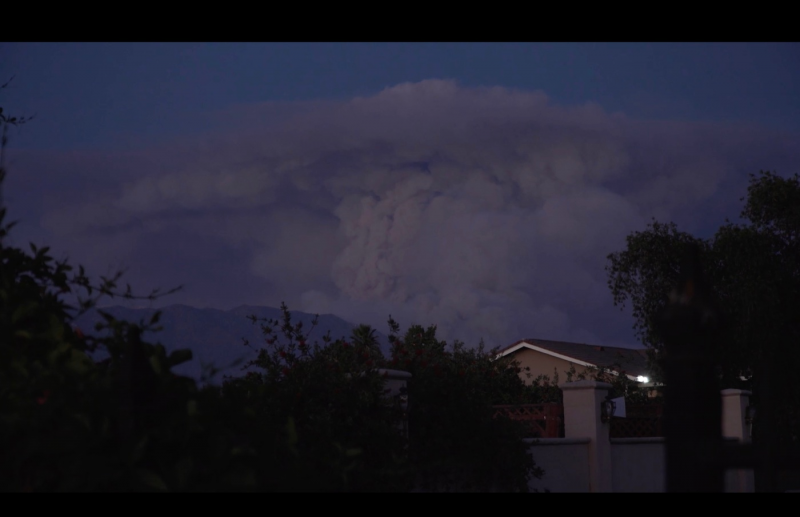
https://www.crypto-fiction.com/on-demand
Watch a conversation with the filmmakers below.
In these four distinct experimental documentaries, each artist takes us on a journey of introspection, embracing an inventive cinematic language that sparks us into thinking about the fragility of our place on this earth. In each film, we are given a new context by which to grapple with the delicacy of the mind, the body and the image.
In “The Whelming Sea”, Sean Hanley shares a side of New York City that most of us have never seen. With tenderness and insight, he unveils the wild adventure of the horseshoe crab as it lands on the beaches of New York City, one of the largest metropolises in the United States. With our climate as overwhelmed as it is, this could be a very distressing migration story, but somehow these animals survive.
Tiff Rekem’s “Declarations of Love” witnesses the filmmaker’s father struggling in his own sardonic way to survive modern life. Hardly daunted by the encroaching fires broiling within view of his comfortable desert home, he mows the lawn, feeds his turtle and deals with the intricacies of a befuddled customer service caller. He can’t be too lonely; his daughter is there, behind the camera, giving him all
the permissions he needs to simply be himself.
Artist rebecca shapass brings us into a dystopic cosmos that is both familiar and other-worldly in her film “no more room in hell”. Inhabited by zombies rather than people or animals, this liminal nocturnal space never truly witnesses the light of day. Inside a decaying industrial cityscape, we are thrown into the spirit of a late 1960s George Romero horror film through the trajectory of a driverless car. Together, these disparate milieus propel us into thinking about our propensity to go as fast as we can toward oblivion.
In Erica Sheu’s cine-poem “Grandmother’s Scissors” we find an intimate silent conversation built around the exchange of images and lines of poetic text shared by a grand-daughter filmmaker with her seamstress grandmother. Ingeniously constructed like a filmic tapestry, Sheu’s celebration of her elder gives voice to a woman who knows that strength come to us all by way of a “strong heart” and a bold,
confident vision.
The Whelming Sea by Sean Hanley (29 mins, color, sound, 2020)
Declarations of Love by Tiff Rekem (29 min. color, sound, 2022)
no more room in hell by rebecca shapass (23 min., color, sound, 2023)
Grandma’s Scissors by Erica Sheu (6 min, Super 8, color & b/w, silent, 2021
Watch the four films here: https://vimeo.com/ondemand/lynnesachscurated
Read more via PDF here.
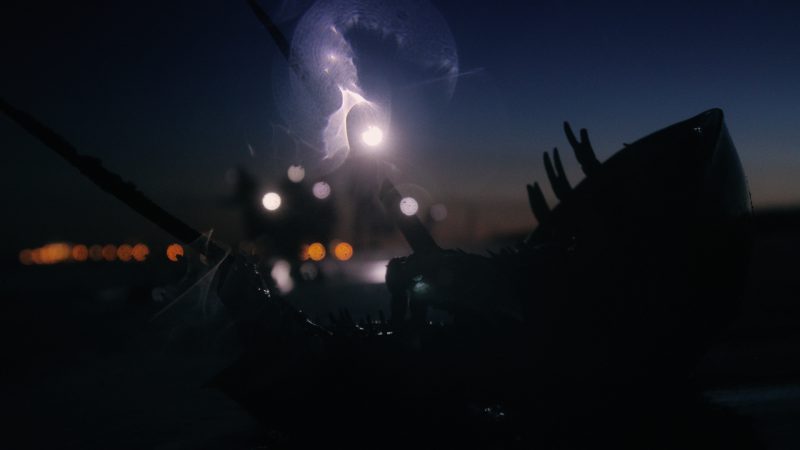

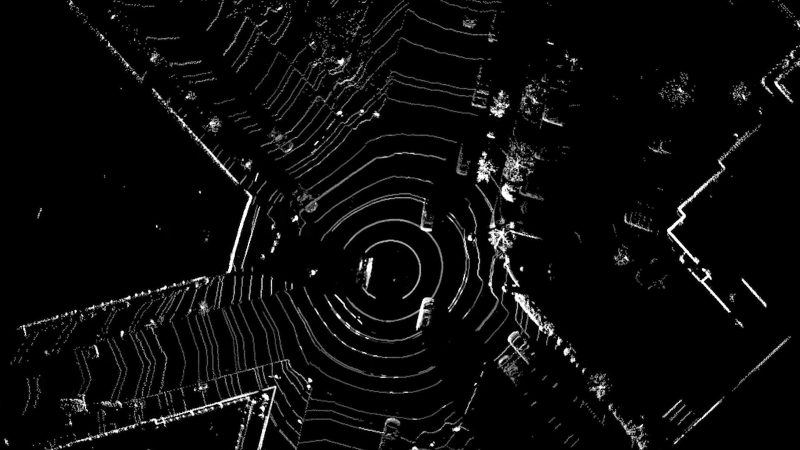

Lynne Sachs Awarded a New York State Council on the Arts Support for Artists Grant.
Brooklyn, NY – Lynne Sachs received a Support for Artists grant
from the New York State Council on the Arts (NYSCA) to support her creative
work. Sponsored by Urban Video Project, this award will fund This Side of Salina.
Through New York State’s continued investment in arts and culture, NYSCA has
awarded over $80 million since Spring 2023 to over 1,500 artists and organizations
across the state.
Governor Kathy Hochul said, “Research confirms what we’ve always known here in
New York: arts and culture are a powerhouse, with a staggering return on investment
for our economy and our communities. Nonprofit arts and culture organizations and their
audiences generated $151.7 billion in economic activity nationwide in 2022 and New
York’s unparalleled arts and culture sector is leading the way to benefit our residents,
our students and our visitors every day. I commend these grantees on their
achievements and look forward to their contributions in the coming year.”
NYSCA Chair Katherine Nicholls added, “Thanks to the unwavering support of
Governor Hochul and our Legislature, NYSCA is so proud to support the work of
organizations and artists from all across New York. Spanning the entire breadth of the
arts and culture sector – from world-renowned performers to after-school programs,
from long established museums to community arts collectives – these organizations and
artists together are a powerful driver of health, tourism, economy and education for our
residents and visitors. On behalf of Council and staff, congratulations to Lynne Sachs and thank you for your perseverance, your creativity and your tireless service to
New York State.”
About the New York State Council on the Arts
The mission of the New York State Council on the Arts is to foster and advance the full
breadth of New York State’s arts, culture, and creativity for all. To support the ongoing
recovery of the arts across New York State, the Council on the Arts will award $127
million in FY 2024. The Council on the Arts further advances New York’s creative
culture by convening leaders in the field and providing organizational and professional
development opportunities and informational resources. Created by Governor Nelson
Rockefeller in 1960 and continued with the support of Governor Kathy Hochul and the
New York State Legislature, the Council is an agency that is part of the Executive
Branch.
Almost 200 years ago, a group of Central New York women gathered together to voice their opposition to the fact that women in the United States had no legal identity separate from their husbands, were unable to sign contracts, vote, own property, obtain access to education, or gain custody of their children after divorce. Ever since those pivotal conversations were held at the first women’s rights convention in Seneca Falls, New York in 1848, women have been slowly but surely claiming their place in society in terms of their ability to make their own decisions about their own lives. This sense of progress came to an abrupt ending on June 24, 2022, when the U.S. Supreme Court made a landmark decision which held that the Constitution does not confer a right to abortion. Throughout the country, women were told that they no longer had control of their own bodies.
I come to the topic of abortion fully aware of its volatile place in our country’s story. Tensions between the role of the state and bodily freedom go back to the very earliest days of our nation’s history. Just as the 1619 Project reignited the conversation around race and the pivotal place of slavery in this country’s narrative in 2020, newly charged debates around the legality of abortion force us to recognize the precarious relationship that women in this country have to their own bodies.
With the support of Light Work through their Urban Video Project, I will create “This Side of Salina, a 15-minute film and two associated live performances which will bring people with uteruses and their allies together in an area of New York State that has long been known as a hotbed for feminist outrage and action. In collaboration with a range of organizations from Syracuse and neighboring towns, I will work with approximately 20 experienced and emerging artists as well as other interested participants. I will produce, photograph and record movements, gestures and spoken word poetry that emerge from our discussions around this disturbing and far-reaching shift in American society. Each of us will come to this moment as a witness to a problematic moment in our collective history.
My creative process for “This Side of Salina” will include connecting with organizations such as the Syracuse Community Choir and Sankofa Reproductive Health and Healing Center as well as student, art, religious, and activist groups in the area. In addition, as part of my research, I plan to reach out to Syracuse-based artists and performers, including poet and chant performance artist Amarachi Attamah, as well as Syracuse performance and conceptual artist Sayward Schoonmaker, whose recent piece “Majority Opinion (Presented from the Majority Perspective)” uses the Supreme Court’s Majority Opinion from the Dobbs case as source material for a verbatim documentary performance.
On June 24, 2023, the one-year anniversary of the Dobbs decision, I returned to my own hometown of Memphis, Tennessee to produce one section of a collaborative film project about abortion clinics across the country closing their doors in the wake of the overturning of Roe v Wade. In “This Side of Salina”, I will further develop the aesthetic experimentation I began in this collaborative project. I am including five images from this project in my proposal. In Syracuse, I will photograph all of the participants either from behind, out-of-focus or in silhouette, which will allow them to express their responses to the issues we are exploring in a more physical, less traditionally “dramatic” form. There will be no faces in this film. In this way, our participants – whether they are new to this kind of improvisational work or veterans from the stage or screen – will work quasi-anonymously, as performers articulating a collective yet diverse point-of-view.
During my residency in Syracuse, I will also draw from my experience as a poet and a filmmaker with years of experience working with groups in both of these art forms, most recently at the Flowchart Foundation and the Poetry Society of America (both in New York State). I will ask my performers/ participants to write short texts that we will then shape into song. By working with local choral groups, we will bring these words into the film as a whole, emphasizing the sensation of “a loud whisper” which will allow listeners to hear distinctive articulations as well as a collective, musical breath. In this context, I would very much like to bring in internationally recognized singers Pamela Z and Josephine Foster (either in person or through video conference) to help us expand our relationship to the musical potential of voice and text. I believe that the vocal nature of this work will result in an aural experience that will be extremely moving for spectators (passers-by or attentive viewers) watching the film outside the Everson Museum.
My own interdisciplinary engagement with film and live performance includes two distinct projects created in New York City. In “Your Day is My Night” (2011 -2013), I blended autobiographical monologues, intimate conversations, and staged performances to explore the lives of Chinese immigrants sharing a “shift-bed” apartment in the heart of Chinatown. Working with seven performers over two years, we presented our piece in theaters and community centers in Manhattan and Brooklyn. In “Every Fold Matters” (a live performance with film presented from 2015 -2018) and later “The Washing Society” (a 45 min. film, 2018), I explored the charged, intimate space of the neighborhood laundromat by bringing together the people who work there with professional actors. Both of these projects are included as work samples in this proposal.
The final version of “This Side of Salina” will be a film and two live performances. I will direct both the film and the live component of this project. The film itself will be exhibited over three to four months during the 2024-25 program year as part of the Urban Video Project’s on-going architectural projection program. The two performances will also occur outside the museum in conjunction with the film screening.
A few weeks ago, I shot outside a former abortion clinic in Tennessee, one of the states in the US where abortion is no longer legal for ANY reason. I’ve been making films for three decades. I do not exaggerate when I say that this was probably the riskiest, most vulnerable film shoot I have ever directed. We had sixteen participants : 12 young women of child-bearing age, one older woman and two men. Everyone knew that it was potentially dangerous to make a film about abortion outside a building where these services had once been available but now are not. I did not tell my participants where we would be shooting until two days before our production date. We had several volunteer marshals to help with security, waiting in their cars or behind windows in nearby buildings in case anything happened. As precarious as we all felt at the time, standing in the scorching summer heat in medical gowns performing before a large camera, we were all excited, nervous and absolutely committed. While the stakes are not as precarious in New York, the issues resonate just as much. In Syracuse at the Everson Museum, I will work on these same issues, recognizing the long activist history of the region but also finding new ways to address the disturbing expansion of state control on women and their bodies.
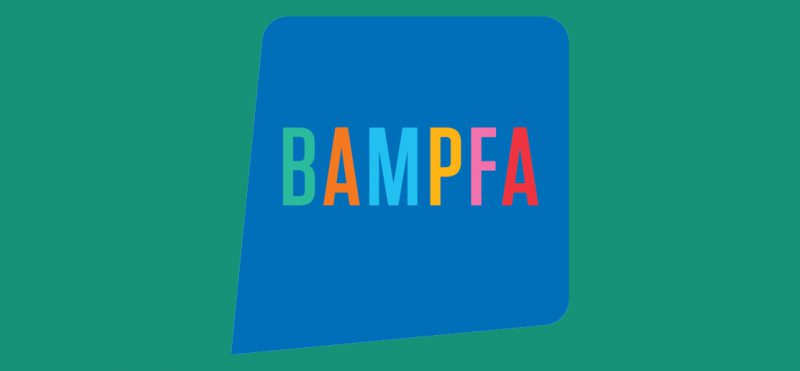
https://oac.cdlib.org/findaid/ark:/13030/c8x06fvr/?query=lynne+sachs
Collection Title: Sachs (Lynne) Collection
Collection Number: PFA.MSS.017
Get Items: Contact UC Berkeley::Berkeley Art Museum and Pacific Film Archive
Description: The collection represents the work of experimental documentary filmmaker Lynne Sachs, who has worked primarily in the San Francisco Bay Area and New York City since the 1980s. Included are articles and film screening notes about Sachs and her films; essays and other writings by Sachs; correspondence with other filmmakers including Barbara Hammer and Sylvia Schedelbauer; as well as still images and artist’s statements from each of the videos included in the original donation.
Background: Lynne Sachs is a New York-based filmmaker whose work combines experimental and documentary film traditions with a strongly feminist perspective. She has produced over 40 films as well as many performances and installation works, and publishes essays and poetry as extensions of her visual arts practice. Her films have screened at prestigious institutions and festivals worldwide and won numerous awards, including the 2020 Grand Prize at the International Short Film Festival Oberhausen for a film made together with fellow experimental filmmaker Barbara Hammer. Sachs began making films in San Francisco while attending San Francisco State University and the San Francisco Art Institute, drawing inspiration from and collaborating with many filmmakers including Bruce Conner, George Kuchar, Gunvor Nelson, Carolee Schneemann, and Trinh T. Min-ha. Sachs has also taught filmmaking at New York University, Hunter College, and the University of California, Berkeley, among other institutions.
Extent: 2.5 cartons Generally printouts and photocopies of flyers, essays, correspondence, and press clippings.
Availability: The collection is open for research in person in the BAMPFA Film Library and Study Center. Remote access to digital files in the collection is not currently possible, pending arrangements with the donor. Please contact the Berkeley Art Museum and Pacific Film Archive Film Library and Study Center for details.

A selection of these films and more will screen at Film Forum in February 2024 as part of the two-week series, Sapph-O-Rama!, a celebration of the lesbian film canon and a survey of sapphic cinema through the last century. Programmed by Emily Greenberg and myself.